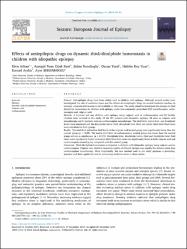| dc.contributor.author | Arhan, Ebru | |
| dc.contributor.author | Çıtak Kurt, Ayşegül Neşe | |
| dc.contributor.author | Neşelioğlu, Salim | |
| dc.contributor.author | Yerel, Özcan | |
| dc.contributor.author | Koç Uçar, Habibe | |
| dc.contributor.author | Aydın, Kürşad | |
| dc.contributor.author | Serdaroğlu, Ayşe | |
| dc.date.accessioned | 10.07.201910:49:13 | |
| dc.date.accessioned | 2019-07-10T19:49:42Z | |
| dc.date.available | 10.07.201910:49:13 | |
| dc.date.available | 2019-07-10T19:49:42Z | |
| dc.date.issued | 2019 | en_US |
| dc.identifier.citation | Arhan, E., Çıtak Kurt, A. N., Neşelioğlu, S., Yerel, Ö., Koç Uçar, H., Aydın, K. ... Serdaroğlu, A. (2019). Effects of antiepileptic drugs on dynamic thiol/disulphide homeostasis in children with idiopathic epilepsy. Seizure European Journal of Epilepsy, 65, 89-93. https://dx.doi.org/10.1016/j.seizure.2018.12.019 | en_US |
| dc.identifier.issn | 1059-1311 | |
| dc.identifier.issn | 1532-2688 | |
| dc.identifier.uri | https://dx.doi.org/10.1016/j.seizure.2018.12.019 | |
| dc.identifier.uri | https://hdl.handle.net/20.500.12511/1728 | |
| dc.description | WOS: 000460712900014 | en_US |
| dc.description | PubMed ID: 30641413 | en_US |
| dc.description.abstract | Purpose: Anti-epileptic drugs have been widely used in children with epilepsy. Although several studies have investigated the role of oxidative stress and the effects of antiepileptic drugs on several oxidative markers in epilepsy, adequate information is not available on this issue. This study aimed to investigate the changes in thiol disulphide homeostasis in children with epilepsy under two commonly prescribed AED monotherapies, carbamazepine and valproic acid. Methods: A hundred and one children with epilepsy using valproic acid or carbamazepine and 58 healthy children were included in this study. Of the 101 patients with idiopathic epilepsy, 58 were on valproic acid monotherapy and 43 patients were on carbamazepine monotherapy. The total thiol, native thiol, and disulphide levels were measured and the disulphide/native thiol, disulphide/total thiol and native thiol/total thiol ratios were calculated in both groups. Results: The total thiol and native thiol levels of the valproic acid treated group were significantly lower than the control group (p < 0.05). The native thiol level of carbamazepine treated group was lower than the control group without a significance (p = 0.123). Disulphide level, disulphide/native thiol and disulphide/total thiol ratios were significantly higher and native thiol/total thiol ratio was significantly lower in both valproic acid and carbamazepine treated group compared with the control group. Conclusion: Thiol/disulphide homeostasis is impaired in children with idiopathic epilepsy using valproic acid or carbamazepine. Valproic acid which is frequently used in childhood epilepsy may modify this balance more than carbamazepine monotherapy. More importantly, the new method used in our study proposes a promising, practical and daily applicable test for evaluating oxidative stress in these patien | en_US |
| dc.language.iso | eng | en_US |
| dc.publisher | W B Saunders Co Ltd | en_US |
| dc.rights | info:eu-repo/semantics/openAccess | en_US |
| dc.subject | Epilepsy | en_US |
| dc.subject | Dynamic Thiol / Disulphide Homeostasis | en_US |
| dc.subject | Valproic Acid | en_US |
| dc.subject | Carbamazepine | en_US |
| dc.title | Effects of antiepileptic drugs on dynamic thiol/disulphide homeostasis in children with idiopathic epilepsy | en_US |
| dc.type | article | en_US |
| dc.relation.ispartof | Seizure European Journal of Epilepsy | en_US |
| dc.department | İstanbul Medipol Üniversitesi, Tıp Fakültesi, Dahili Tıp Bilimleri Bölümü, Çocuk Sağlığı ve Hastalıkları Ana Bilim Dalı | en_US |
| dc.authorid | 0000-0003-1513-6149 | en_US |
| dc.identifier.volume | 65 | en_US |
| dc.identifier.startpage | 89 | en_US |
| dc.identifier.endpage | 93 | en_US |
| dc.relation.publicationcategory | Makale - Uluslararası Hakemli Dergi - Kurum Öğretim Elemanı | en_US |
| dc.identifier.doi | 10.1016/j.seizure.2018.12.019 | en_US |
| dc.identifier.wosquality | Q3 | en_US |


















